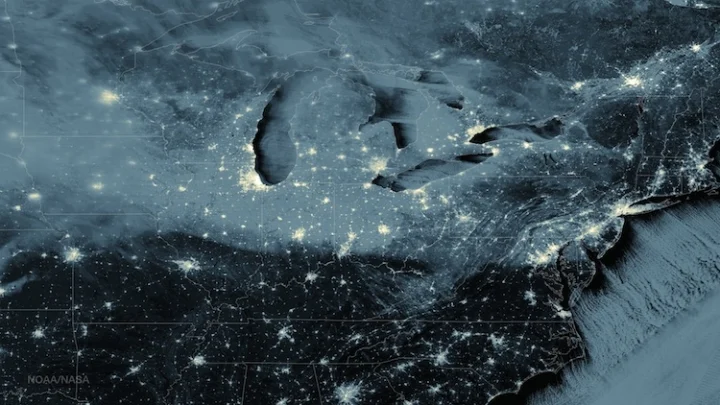News•January 9, 2015
Picture This: So Cold It Snowed in Florida
So, it got pretty cold this week. How cold? It snowed in Florida.
But snow wasn’t the only sign of winter: Temperatures and wind chills plummeted across much of the country as Arctic air surged southward, leading to some stunning maps, teeth-chattering sights and serious bundling up. As a country, that cold was offset by record warm temperatures in the western U.S., coming just after a record hot year for some western states.
But first, that snow in Florida.
Sunshine State Snow
As the Arctic air pushed further and further south across the country, that cold air met the relative warmth of the ocean waters off Florida’s northeast coast. That air was so cold it froze the water in a fountain in Pensacola:
@spann Plaza Ferdinand VII Downtown Pensacola, Florida pic.twitter.com/ZWuLFp9hny
— jharoldbriggs (@jharoldbriggs) January 8, 2015
Like the lake effect snow common around the Great Lakes in winter (and which buried Buffalo in November during a particularly strong event), this “ocean effect” snow is a product of that temperature discrepancy between air and water. As the cold air sweeps over the ocean, water evaporates and warms the air layer just above the ocean. That warm air rises, cooling as it does so, until it reaches the point where the water in it freezes and falls as snow. If the winds blow onshore, that snow falls on land, as you can see in this radar image:
You know of #LakeEffect snow. How about #Florida ocean effect #snow today? Via @wxbrad. #FLwxpic.twitter.com/IoOZr2MZCA
— John Morales (@JohnMoralesNBC6) January 8, 2015
And that’s how you get scenes like this one in Jacksonville:
RT @NWSMiami: Snow flurries falling at the NWS office @NWSJacksonville. Thursday, January 8 about 3 PM. pic.twitter.com/JIFZI29mAa
— Andrea Butera (@AndreaButera) January 8, 2015
Big (Frozen) Picture:
As always, some of the best images of the Arctic takeover came from space and nationwide maps that showed the extent of the deep freeze. This map shows how much colder much of the country was compared to average for January:
Yep, it sure is cold where you live in the US of A. #USAUSA! pic.twitter.com/pDiQo9MW1w
— Capital Climate (@capital_climate) January 8, 2015
(Note, though, how much warmer the Arctic is at the same time.)
On Wednesday, as the cold air seeped southward, the temperature difference across the U.S. was an amazing 126°F:
Quite #cold this morning! Current 126 degree #US “feels like” temp differential. Reminder: this isn't unprecedented. pic.twitter.com/NruY6eI4P1
— Steve Bowen (@SteveBowenWx) January 7, 2015
On Thursday, the national map showed that more than three quarters of the continental U.S. was below freezing, with an average temperature of just 17.9°F. Ouch.
At 8 a.m. ET, 84% of lower 48 states was <32 deg F. U.S. average temp was just 17.9 deg F! http://t.co/g3TizwDAt4pic.twitter.com/Jt3aJCxFtm
— Andrew Freedman (@afreedma) January 8, 2015
But the best view came courtesy of the Suomi NPP satellite, which can take nighttime shots of the country. It spotted the snow that blanketed the northern tier of states along with the bright lights of urban areas:
Snow blankets parts of the eastern U.S. in this image taken Thursday by the Suomi NPP satellite.
Credit: NASA/NOAA

Colder than Mars
Wind chills dipped so low across parts of Canada and the northernmost U.S. that they were colder than Mars. Yes, that Mars.
Mars warmer than parts of Canada, U.S. http://t.co/2Gi89QlU5Xpic.twitter.com/GwdGZFArjS
— CBC Tech and Science (@CBCTechSci) January 9, 2015
Western Warmth
Of course, while everyone east of the Rockies was bundled up like this:
Everyone in the eastern U.S. this week—> RT @AndreaTWeather: @capitalweatherpic.twitter.com/nqqUvmlvnw
— Capital Weather Gang (@capitalweather) January 7, 2015
Folks out West were enjoying some record-warm temperatures, with parts of Arizona and California reaching into the 80s, including Phoenix, which was hosting the annual meeting of the American Meteorological Society. Well played, meteorologists.
Those temps continued a trend of anomalous warmth all through 2014 in the western states. It was announced this week that both California and Alaska had record-hot years last year:
It's official: 2014 was California's record warmest year by an incredible 1.8F margin. #cawx#cadrought#cawaterpic.twitter.com/JRCHrBVxQW
— Daniel Swain (@Weather_West) January 8, 2015
**Record Alert** 2014 is officially the warmest year on record for Alaska. Records started in 1918 #akwxpic.twitter.com/eH7m43ocrc
— NWS Alaska Region (@NWSAlaska) January 8, 2015
Let It Snow
Going back to the cold, not everyone minded the wintry weather. The ever-industrial students of Georgia Tech decided to take advantage of the chill to make their own snow day:
When it's this cold and no snow, our students just engineer their own with devices they build. #HelluvaEngineerspic.twitter.com/2eUcx0nIcN
— Georgia Tech (@GeorgiaTech) January 8, 2015
And to end the week on a much-needed cute note, the National Zoo’s baby panda, Bao Bao, got her first taste of snow. The verdict? She loved it:
Today was Bao Bao's first time playing in the snow! And she totally rocked it. pic.twitter.com/gT3dDa92fh
— National Zoo (@NationalZoo) January 6, 2015